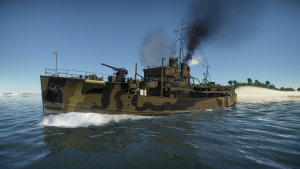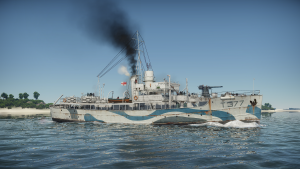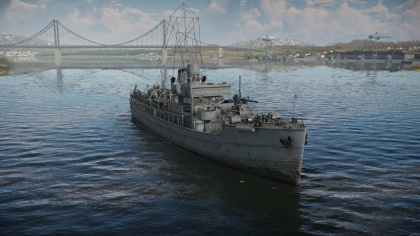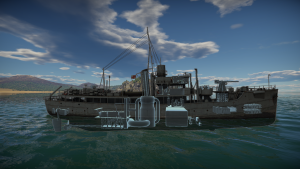HMS Liscomb
Contents
Description
The Isles-class, HMS Liscomb (T-285) is a rank II British sub-chaser
with a battle rating of 2.0 (AB) and 2.3 (RB/SB). It was introduced in Update 1.83 "Masters of the Sea" as part of the British fleet Closed Beta Test.
General info
Survivability and armour
Isles class (T-285) has the following armour layout:
- 20 mm/70 Oerlikon Mk.II) gunshields: 12.7 mm, hardened armour
- Hull: 6 mm, steel
- Superstructure: 4 mm, steel
Any gun in the game is able to penetrate anywhere on the boat, including the gunshields, at practically any range.
There is currently no gun in the game that can hull-break Isles class (T-285).
Isles class (T-285)'s hull is split into four compartments. The first compartment starts at the bow and ends where the raised forecastle ends, just in front of the forward 4 in QF Mark V cannon. The second starts the end of the forecastle and ends in front of the bridge. The third starts at the bridge and ends in front of the aft 20 mm/70 Oerlikon Mk.II mount. The fourth starts at the aft gun mount and ends at the stern. Isles class (T-285) is notable for being one of the only rank I boats to have the "Shrapnel Protection" modification, though this doesn't affect survivability much. With a crew complement of 40, overall survivability is high.
Isles class (T-285) has two types of ammo racks: one ammunition storage and one shells room. The ammunition storage is located below the forward 4 in QF Mark V cannon; it is never emptied. The shells room is split into two locations (though damaging one will also damage the other): one below the ammunition storage and one in the bow, both above the waterline; it is emptied when there is only one round of ammunition remaining for the forward 4 in QF Mark V cannon. Destroying either the ammunition storage or the shells room does not destroy the boat.
Mobility
| Mobility Characteristics | |||||
|---|---|---|---|---|---|
| Game Mode | Upgrade Status | Maximum Speed (km/h) | Turn Time (s) | Turn Radius (m) | |
| Forward | Reverse | ||||
| AB | Stock | 25 | 11 | ~127.36 | ~95.72 |
| Upgraded | 34 | 15 | ~67.95 | ~60.08 | |
| RB/SB | Stock | 19 | 8 | ~187.63 | ~107.84 |
| Upgraded | 22 | 10 | ~127.78 | ~90.39 | |
Isles class (T-285) has a displacement of 554 tons.
Armament
Primary armament
For her primary armament, Isles class (T-285) has one 4 in QF Mark V cannon in a single mount forward. It has 150 rounds of ammunition available for it. Stock, the mount can traverse horizontally at a rate of 10°/s and vertically at a rate of 6.8°/s; with the "Primary Armament Targeting" modification installed, it can traverse horizontally at a rate of 12°/s and vertically at a rate of 8°/s. The gun is single-shot and has a nominal rate of fire of 12 rounds/min. With a stock crew, it can be reloaded in 6.5 seconds; with an aced crew, it can be reloaded in 5 seconds.
| Guidance for the Primary Gun Turret | |
|---|---|
| Horizontal | Vertical |
| ±180° | -7°/+80° |
There are three choices of ammunition available:
- 4 inch HE
- 4 inch SAP
- 102 mm shrapnel
| Penetration Statistics | |||||||
|---|---|---|---|---|---|---|---|
| Ammunition | Type | Penetration @ 0° Angle of Attack (mm) | |||||
| 1000 m | 2,500 | 5,000 m | 7,500 m | 10,000 m | 15,000 m | ||
| 4 inch HE | HE | 11 | 11 | 11 | 11 | 11 | 11 |
| 4 inch SAP | SAP | 90 | 75 | 60 | 52 | 46 | 40 |
| 102 mm shrapnel | Shrapnel | 5 | 5 | 5 | 5 | 5 | 5 |
| Shell Details | |||||||||||
|---|---|---|---|---|---|---|---|---|---|---|---|
| Ammunition | Type | Projectile Mass (kg) | Velocity (m/s) | Explosive Type | Explosive Mass (kg) | TNT Equivalent (kg) | Fuse Delay (m) | Fuse Sensitivity (mm) | Ricochet | ||
| 0% | 50% | 100% | |||||||||
| 4 inch HE | HE | 14.06 | 805 | TNT | 0.721 | 0.721 | N/A | 0.1 | 79° | 80° | 81° |
| 4 inch SAP | SAP | 15.2 | 805 | Amatol | 0.520 | 0.520 | 3 | 3 | 47° | 60° | 65° |
| 102 mm shrapnel | Shrapnel | 17.7 | 805 | TNT | 0.218 | 0.218 | N/A | 0.1 | 62° | 69° | 73° |
Secondary armament
For her secondary armament, Isles class (T-285) has three 20 mm/70 Oerlikon Mk.II cannons in three single mounts, one aft and two on either side in front of the bridge. For each mount, there are 1,200 rounds of ammunition available for a total of 3,600 rounds. Stock, each mount can traverse horizontally at a rate of 64°/s and vertically at a rate of 64°/s; with the "Auxiliary Armament Targeting" modification installed, they can traverse horizontally at a rate of 75°/s and vertically at a rate of 75°/s. Each gun has a belt capacity of 60 rounds and a rate of fire of 450 rounds/min. With a stock crew, they can be reloaded in 2.9 seconds; with an aced crew, they can be reloaded in 2 seconds. Their maximum range against surface targets is roughly 2.1 km.
| Turrets are named sequentially, clockwise, starting at the bow |
| Guidance for the Secondary Gun Turrets | |||||||
|---|---|---|---|---|---|---|---|
| No.1 Turret | No.2 Turret | No.3 Turret | |||||
| Horizontal | Vertical | Horizontal | Vertical | Horizontal | Vertical | ||
| ±180° | -5°/+70° | ±180° | -5°/+70° | ±180° | -5°/+70° | ||
There are three choices of ammunition available:
- Universal: HEF-T/HEF-I/AP-T
- 20 mm HE: HEF-T/HEF-I/AP-T/HEF-I
- 20 mm AP: AP-T/AP-T/AP-T/HEF-I
| Penetration Statistics | ||||||
|---|---|---|---|---|---|---|
| Ammunition | Penetration @ 0° Angle of Attack (mm) | |||||
| 10 m | 100 m | 500 m | 1,000 m | 1,500 m | 2,000 m | |
| Universal | 35 | 33 | 26 | 21 | 18 | 15 |
| 20 mm HE | 35 | 33 | 26 | 21 | 18 | 15 |
| 20 mm AP | 35 | 33 | 26 | 21 | 18 | 15 |
Anti-aircraft armament
For her anti-aircraft armament, Isles class (T-285) has four 7.72 mm Lewis 1916 machineguns in two twin mounts, one on either side of the bridge. For each mount, there are 3,880 rounds of ammunition available, 1,940 rounds per gun, for a total of 7,760 rounds. There are no stated horizontal or vertical traverse rates given in-game, though the mounts handle very similarly to, if not exactly the same as, other twin and quadruple 7.72 mm Lewis 1916 machinegun mounts which, when stock, can all traverse horizontally at a rate of 64°/s and vertically at a rate of 64°/s; with the "Anti-Air Armament Targeting" modification installed, traverse horizontally at a rate of 75°/s and vertically at a rate of 75°/s. Each gun has a magazine capacity of 97 rounds and has a rate of fire of 550 rounds/min. With a stock crew, the guns can be reloaded in 10.4 seconds; with an aced crew, they can be reloaded in 8 seconds. Their maximum range against surface targets is roughly 1.6 km.
| Turrets are named sequentially, clockwise, starting at the bow |
| Guidance for the Anti-Aircraft Gun Turrets | |||||||
|---|---|---|---|---|---|---|---|
| No.1 Turret | No.2 Turret | ||||||
| Horizontal | Vertical | Horizontal | Vertical | ||||
| ±55° | -5°/+50° | ±55° | -5°/+50° | ||||
No ammunition choices are available for this gun. Although not directly stated in-game, the guns fire one tracer round every other round, so they most likely use the standard Default ammunition choice of the 7.72 mm Lewis 1916 machinegun which has the following composition and penetration statistics:
- Default: AP/T/AP/T
| Penetration Statistics | ||||||
|---|---|---|---|---|---|---|
| Ammunition | Penetration @ 0° Angle of Attack (mm) | |||||
| 10 m | 100 m | 500 m | 1,000 m | 1,500 m | 2,000 m | |
| Default | 10 | 9 | 8 | 7 | 6 | 5 |
Special armament
Isles class (T-285) can carry up to 20 Mk.VII depth charges. These are split into two chutes on the stern carrying 10 depth charges each. They drop one at a time in this order: alternating port and starboard starting on the port side.
Before spawning, the detonation time delay for both types of depth charges can be set anywhere between 3 seconds and 10 seconds.
| Depth Charge Characteristics | |||
|---|---|---|---|
| Mass (kg) | Explosive Type | Explosive Mass (kg) | TNT Equivalent (kg) |
| 196 | TNT | 130 | 130 |
Usage in battles

Lacking in speed, Isles class (T-285) is best used as a support vessel. Stay at the back of the rest of the team and use the 4 in QF Mark V cannon to take out any tough enemies the team may have trouble dealing with. Priority targets include other large vessels such as sub-chasers, German barges, and Soviet armoured guns boats, since, in one way or another, all of these possess high survivability and powerful armaments, making them difficult for smaller boats to effectively engage. In particular, prioritize Soviet armoured gun boats. These are some of the only boats in rank I and rank II with any substantial armour, and the 4 in QF Mark V cannon, with its SAP round, is one of the only guns that can reliably penetrate them when angled. If possible, try to aim for their ammunition storages located below their guns at the waterline. This will almost always result in a one-shot kill. Otherwise, target the heavily-armoured "citadel" at the centre of the boats as, chances are, the less-armoured bow and stern compartments may already be destroyed. For larger vessels such as subchasers, use the shrapnel round; for all other targets, the HE round will suffice.
Despite being one of the largest guns at its tier, the 4 in QF Mark V cannon cannot hull-break, requiring multiple hits to take out even the smallest boats. Because of the cannon's relatively poor accuracy and slow traverse rates, reliably landing shots on small, fast boats may be difficult. For such targets, switch to the secondary 20 mm/70 Oerlikon Mk.II cannons. Because of the way the cannons are arranged, only two of them can ever be aimed at a target at once. Nevertheless, the two cannons actually fire more TNT per minute when using the 20 mm HE belt than the 4 in QF Mark V cannon can with its HE round, so they will usually be enough to handle most boats. However, the 20 mm cannons may struggle against certain armoured targets, so always be prepared to switch back to the 4-inch cannon.
Primarily, Isles class (T-285) should be played away from the fray, sniping dangerous targets from afar. Try to always keep the hull pointed directly towards the enemy, i.e. show as little of the sides as possible. Due to Isles class (T-285)'s massive bulk, the middle and rear hull compartments will become virtually immune from fire. While there are ammunition storages located in the bow, it appears as though they never detonate when destroyed, so tanking damage with the bow is a very viable tactic. This doesn't make Isles class (T-285) completely invincible though, since some crew can still be chipped away by destroying the bridge and gun mounts, but it does substantially increase survivability. Isles class (T-285) is extremely vulnerable to artillery strikes and, to a lesser extent, torpedoes. Always try to stay on the move and occasionally change direction to through off their aim.
Another way to play Isles class (T-285) is to take it into close-range engagements around capture points, using the 20 mm/70 Oerlikon Mk.II cannons and levering Isles class (T-285)'s high survivability to take out smaller boats before they can deal any significant damage back. When playing like this, remember that none of the 20 mm cannons can fire in a ~45° arc directly forwards, and only one of them can fire in a ~70° arc directly aft, so always keep enemies to the sides to maximize firepower. Additionally, the 20 mm cannons cannot depress far enough to target anything within a ~60 m radius around the boat, so don't let enemies get too close and avoid staying near islands and other forms of cover for too long. Isles class (T-285) is also more susceptible to artillery and torpedoes at close range, so as with playing at long-range, always keep moving. Another thing to note is that while controlling the 20 mm cannons, there will be no effective AI-controlled anti-aircraft weapons. Isles class (T-285) makes for an easy target for aircraft due to her large size and low speed, so periodically check the skies and, if you're not confident with your aim, switch back to the 4-inch cannon to give control of the 20 mm cannons to the AI gunners. Lastly, be aware that playing at close-range is a much more viable tactic in a downtier. In an uptier, the Isles class (T-285) will face opponents with much more powerful armaments, negating her survivability advantage.
- Ammunition Choices

For the 4 in QF Mark V cannon, the best ammunition choice, in general, is the 4 inch HE round. The 4 inch HE round has the most high-explosive mass among the three rounds that the 4 in QF Mark V cannon has access to, making it the best general-purpose round overall.
The 4 inch SAP rounds should be reserved only for Soviet armoured gun boats. Any other targets will simply not have any sort of armour, and the round will generally over-penetrate the hull without triggering its fuze, dealing minimal damage to the target. Identify the enemy first and only use the SAP round if the other rounds are ineffective.
The 102 mm shrapnel should be used on large targets without armour such as sub-chasers. Against such targets, the HE round will most likely fail to destroy the hull compartments in a single hit, and internal components will rarely be damaged. In contrast, the shrapnel round can consistently destroy their hull compartments, and it creates a cone of spalling upon penetration that can travel much further into the hull. Keep in mind, though, that the shrapnel round will almost always be stopped by any kind of armour and that it only has about 30% of the explosive mass of the HE round, making it less versatile against smaller boats unless specifically aiming for ammunition storages. The shrapnel round also has a timed fuze that could possibly be used against aircraft, though with the 4 in QF Mark V cannon's slow traverse and elevation rates as well as its slow rate of fire, it's better to leave anti-aircraft defence to the other weaponry.
For the 20 mm/70 Oerlikon Mk.II cannons, the best ammunition choice is the 20 mm HE because it has the highest ratio of HE rounds to AP rounds, making it the most effective against both aircraft and surface targets. The 20 mm HE belt should be the main ammunition choice, though a small amount of the 20 mm AP belt should also be taken in case any armoured targets get around to the sides of the boat. Aside from ammunition costs, there is no reason to use the Universal belt once the other options have been researched.
- Depth Charges
Being anti-submarine weapons and with the present lack of submarines in the game, there is no practical reason to use depth charges. There is especially no reason to use them on Isles class (T-285) because the depth charges drop off of the stern. Because of Isles class (T-285)'s very slow top speed and bad manoeuvrability, there will almost never be an opportunity to use them. This is doubly so, since, if they are not dropped, depth charges act like exposed and unarmoured ammo racks.
Modules
| Tier | Seakeeping | Unsinkability | Firepower | |||
|---|---|---|---|---|---|---|
| I | Dry-Docking | Tool Set | 4 inch SAP | 20 mm HE | Anti-Air Armament Targeting | |
| II | Rudder Replacement | Fire Protection System | Smokescreen | 102 mm shrapnel | 20 mm AP | Auxiliary Armament Targeting |
| III | Propeller Replacement | Shrapnel Protection | Improved Rangefinder | Depth Charges | Primary Armament Targeting | |
| IV | Engine Maintenance | New Pumps | ||||
Pros and cons
Pros:
- High survivability
- Cannot be hull-broken by any guns in the game
- Primary armament: excellent SAP round
- Secondary armament: great damage output; large magazine capacity
- Stable firing platform
Cons:
- Very low top speed and very bad manoeuvrability
- Extremely susceptible to torpedoes, artillery, and aircraft attacks
- Relatively weak armament
- Primary armament: poor traverse rates; poor accuracy
- Secondary armament: only 2/3 guns can be brought to bear at once
- Anti-aircraft armament: very low damage output; long reloads; bad firing arcs
- No access to artillery support
History
The Isles-class, also known as the Western Isles-class, was a class of 197 Royal Navy naval trawlers built between 1939 and 1945. The Isles-class actually comprised of four separate classes of trawlers: the Tree-class, the Dance-class, the Shakespearean-class, and the Isles-class. While the four classes of trawlers are separate, their overall designs were very similar. All four had a length overall of 164 ft, a beam of 27 ft 8 in, and a deep load displacement of 11 ft 1 in. They were all powered by a single shaft vertical triple expansion boiler producing 850 bhp, giving them a top speed of 12.25 knots. Trawlers used for minesweeping — which includes the Tree-class, the Shakespearean-class, and the Isles-class — were armed with the standard single 3-inch QF 12-pdr 12 cwt cannon on the bow, as well as several Oerlikon 20 mm cannons and 30 depth charges. Trawlers used for anti-submarine operations — in this case, the Dance-class only — were additionally given ASDIC equipment and a 4-inch/45 BL Mk IX cannon in place of the 12-pdr cannon.
The Tree-class was the first attempt at a purpose-built naval trawler by Britain during the Second World War. Based on the design of the previous Basset-class trawler of 1935, 20 Tree-class trawlers were ordered in 1939 at the start of the war, with 19 completed between 1939 and 1940 and one completed in 1942. Of the 20 built, 6 were lost during the war. Of the surviving vessels, all but two were sold off in 1946, with the remaining two sold off in 1948.
Following the Tree-class were two groups of trawlers, the Dance-class and the Shakespearean-class, ordered together later in 1939. Twenty Dance-class and 12 Shakespearean-class trawlers were ordered, with all 32 completed between 1940 and 1941. The Dance-class was similar to the Tree-class but was built for anti-submarine duty and given a 4-inch gun instead of the 12-pdr, while the Shakespearean-class was nearly identical to the Tree-class. One Dance-class and six Shakespearean-class trawlers were lost during the war. Aside from four Dance-class trawlers along with one Shakespearean-class trawler sent to Italy in 1946, as well as one Shakespearean-class trawler sent to Kenya also in 1946, all survivors were sold off in 1946 except for two Dance-class trawlers which were sold in 1947.
Last is the Isles-class consisting of 145 trawlers all built through to the end of the war. The Isles-class was again very similar in design to the previous trawlers, and because the Isles-class was much more numerous than the others, the other classes are often considered subclasses of it. Twenty-three Isles-class trawlers were lost during the war with most survivors sold off in 1946. Several Isles-class trawlers were sent to the Royal Canadian Navy and the Royal New Zealand Navy as well as to the Italian Navy, the Portuguese Navy, and the German Navy. A small number of Isles-class trawlers remained in service with the Royal Navy as late as the 1960s.
HMS Liscomb was one of 16 Isles-class trawlers built for the Royal Navy by Canada. She was ordered 8th August 1941 and was laid down on 1st July 1941 at Kingston Shipyards in Ontario. Liscomb was launched on 23rd March 1942 and commissioned later that year on 8th September as HMS Liscomb (T-285). During the war, HMS Liscomb was one of 8 Isles-class trawlers loaned to the Royal Canadian Navy, although they weren't recommissioned as RCN vessels and still retained their RN crewmen. HMS Liscomb was commanded by the following while on loan to the RCN:
- I.D. Smith, RNVR: 20th August 1942 to February 1944
- Lt. J.C. Smith, RCNR: February 1944 to 16th October 1944
- T/Lt. R.V. Harris, RNVR: 16th October 1944 onwards
After the end of World War II in Europe, HMS Liscomb was returned to the Royal Navy on 17th June 1945 and paid off the same day. She was sold in 1946.
Media
See also
External links
- World War II Database - Isles-class Trawler
- naval-history.net - British vessels lost at sea in World War 2 - Auxiliary Warships - originally published in British Vessels Lost at Sea, 1935-45, His Majesty's Stationary Office, 1947
- For Posterity's Sake - HMS LISCOMB T285
- uboat.net - Anti-Submarine Trawlers
- Harry Tate's Navy - The Trawlers Go To War
Bibliography
- Chesneau, R., & Gardiner, R. (1980). Conway's All the World's Fighting Ships, 1922-1946 (pp. 65-66). London, England: Conway Maritime Press. ISBN 0-85177-1467.
| Britain sub-chasers | |
|---|---|







